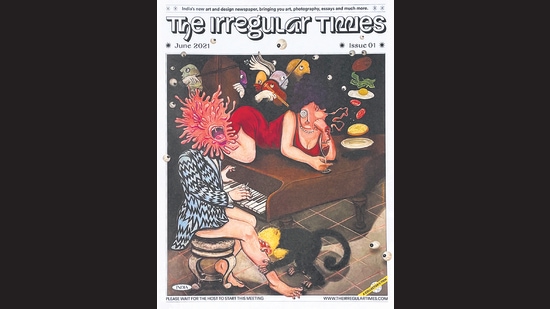The Irregular Times: A new cultural tabloid where art goes paperview
With most galleries and events online or off limits in the pandemic, artist and curator Tarini Sethi and design entrepreneur Anant Ahuja are reaching out to the community with a ‘handheld’ quarterly print publication.
It can be hard for artists when art moves online. There’s a loss of community, an inability to reach one’s audience as effectively. For artist and curator Tarini Sethi and design entrepreneur Anant Ahuja, as for so many, a sense of fatigue with virtual events set in.

As they wondered what to do to offset it, the longtime friends hit upon a plan. Combining Sethi’s passion for zines and Ahuja’s love for newsprint, they created The Irregular Times (TIRT), a quarterly tabloid print publication launched in June. “With TIRT, we just wanted to experiment with the newspaper as a print form, create something interesting that could bind people and art, be interactive and ‘handheld’,” Ahuja says.
The newspaper aims to be a platform for renowned artists as well as up-and-comers.
“The idea was simple — If people can’t come to see art physically, we decided to take the art to them,” says Sethi. The duo sent out questionnaires, did some market research and found that people were receptive to the idea of a print publication that explored experiments with various art forms, and offered an interactive element.

The goal of the newspaper, as they defined it then, was to highlight fresh perspectives at the intersection of art, media, activism and contemporary culture. TIRT costs ₹750 per issue and is brought out by a team of nine artists and designers.
The publication features essays on different art forms, columns on conservation, poetry, short stories, photography and more. There are how-tos that help educate the reader about a craft, and show how they can practise it at home.
“The idea is for the newspaper to be interactive. Readers can really get their hands dirty in the how-to sections,” says features editor Vasudhaa Narayanan. “We have familiar columns that we used to see as kids, like a colouring page, with a twist. The first adult colouring page was a series of drawings of overlapping nudes that aimed to break taboos around sexuality.”
When deciding the line-up for each issue, Narayanan and Sethi say, they look for content that they would want to see, and would want other artists, designers and readers to be exposed to.
The first edition featured an essay on rewilding in India by conservationist Cara Tejpal, dystopian art by Anpu Varkey, a deep dive into Chiraag Bhakta’s art practice, a spotlight on photographer Harsha Vadlamani’s Chalo Dilli series of photographs, part of a decade-long project he began in 2016, exploring the culture of dissent and protest in India.
“It was a very interesting format for my work to appear in, because when I was making the work, I only had the conventional news publications in mind,” Vadlamani says. “I like that TIRT is irreverent, in both design and content.”
All Access.
One Subscription.
Get 360° coverage—from daily headlines
to 100 year archives.



HT App & Website






